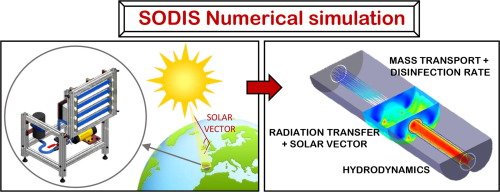Chemical Engineering Journal ( IF 13.3 ) Pub Date : 2018-10-15 , DOI: 10.1016/j.cej.2018.10.131 Ángela García-Gil , Cintia Casado , Cristina Pablos , Javier Marugán

|
A novel procedure for the simulation of solar water disinfection (SODIS) processes in flow reactors is presented. The modeling approach includes the rigorous description of hydrodynamics, radiation transfer, mass transport and bacterial inactivation phenomena within the reactor by means of a computational fluid dynamics (CFD) software. The methodology has been evaluated in a tubular reactor coupled with a compound parabolic collector (CPC). Velocity profiles have been validated versus theoretical fully developed flow, and radiation fields versus both ray tracing and experimental actinometrical measurements. Incorporation of the solar vector calculation significantly improves the model capabilities for prediction of the potential performance of the SODIS process at different geographical coordinates and operation time. A mechanistic kinetic model was used for the description of the bacterial inactivation rate with explicit radiation absorption effects, coupling the radiation field with the mass balances of viable bacterial species. Model predictions successfully reproduce the experimental data of E. coli inactivation under different irradiances of both simulated and natural solar light with a normalized root mean squared logarithmic error (NRMSLE) of 6.65% and 9.72%, respectively. Therefore, this novel methodology is confirmed as a useful tool for the scaling-up of the SODIS process to large volume systems to be installed in remote communities where safe drinking water is not available.
中文翻译:

流动反应器太阳能消毒过程数值模拟的新方法。
提出了一种模拟流动反应器中太阳能消毒(SODIS)过程的新颖程序。建模方法包括通过计算流体动力学(CFD)软件严格描述反应堆内的流体动力学,辐射传递,传质和细菌灭活现象。该方法已在与复合抛物线收集器(CPC)耦合的管式反应器中进行了评估。速度剖面已相对于理论上充分发展的流量进行了验证,辐射场已与射线追踪和实验光化测量进行了验证。合并太阳矢量计算可显着提高模型功能,以预测SODIS工艺在不同地理坐标和运行时间下的潜在性能。使用机械动力学模型描述具有明显辐射吸收作用的细菌失活率,并将辐射场与可行细菌物种的质量平衡联系起来。模型预测成功地再现了的实验数据模拟和自然光在不同辐照下的大肠杆菌失活,归一化均方对数误差(NRMSLE)分别为6.65%和9.72%。因此,这种新颖的方法被确认为将SODIS工艺扩大到大容量系统的有用工具,该系统将安装在无法获得安全饮用水的偏远社区。































 京公网安备 11010802027423号
京公网安备 11010802027423号